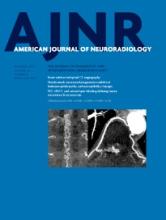Research ArticleNeurointervention
Risk Factors for Hemorrhagic Complications following Pipeline Embolization Device Treatment of Intracranial Aneurysms: Results from the International Retrospective Study of the Pipeline Embolization Device
W. Brinjikji, G. Lanzino, H.J. Cloft, A.H. Siddiqui and D.F. Kallmes
American Journal of Neuroradiology December 2015, 36 (12) 2308-2313; DOI: https://doi.org/10.3174/ajnr.A4443
W. Brinjikji
aFrom the Departments of Radiology (W.B., G.L., H.J.C., D.F.K.)
G. Lanzino
aFrom the Departments of Radiology (W.B., G.L., H.J.C., D.F.K.)
bNeurosurgery (G.L., H.J.C., D.F.K.), Mayo Clinic, Rochester, Minnesota
H.J. Cloft
aFrom the Departments of Radiology (W.B., G.L., H.J.C., D.F.K.)
bNeurosurgery (G.L., H.J.C., D.F.K.), Mayo Clinic, Rochester, Minnesota
A.H. Siddiqui
cDepartment of Neurosurgery (A.H.S.), State University of New York, Buffalo, New York.
D.F. Kallmes
aFrom the Departments of Radiology (W.B., G.L., H.J.C., D.F.K.)
bNeurosurgery (G.L., H.J.C., D.F.K.), Mayo Clinic, Rochester, Minnesota

REFERENCES
- 1.↵
- Arrese I,
- Sarabia R,
- Pintado R, et al
- 2.↵
- Briganti F,
- Napoli M,
- Tortora F, et al
- 3.↵
- Brinjikji W,
- Murad MH,
- Lanzino G, et al
- 4.↵
- Yu SC,
- Kwok CK,
- Cheng PW, et al
- 5.↵
- Kallmes DF,
- Ding YH,
- Dai D, et al
- 6.↵
- Kallmes DF,
- Ding YH,
- Dai D, et al
- 7.↵
- 8.↵
- Cruz JP,
- Chow M,
- O'Kelly C, et al
- 9.↵
- Turowski B,
- Macht S,
- Kulcsár Z, et al
- 10.↵
- Hu YC,
- Deshmukh VR,
- Albuquerque FC, et al
- 11.↵
- Chalouhi N,
- Zanaty M,
- Jabbour PM, et al
- 12.↵
- 13.↵
- Delgado Almandoz JE,
- Crandall BM,
- Scholz JM, et al
- 14.↵
- Kallmes DF,
- Hanel R,
- Lopes D, et al
- 15.↵
- De Leon D,
- Swank G,
- Mirza MA
- 16.↵
- 17.↵
- 18.↵
- Ganesan S,
- Felo J,
- Saldana M, et al
- 19.↵
- Delgado Almandoz JE,
- Crandall BM,
- Scholz JM, et al
- 20.↵
- Takigawa T,
- Suzuki K,
- Sugiura Y, et al
- 21.↵
- 22.↵
- 23.↵
- 24.↵
- 25.↵
- Chiu AH,
- Wenderoth J
- 26.↵
- Murakami H,
- Inaba M,
- Nakamura A, et al
- 27.↵
- Tan LA,
- Keigher KM,
- Munich SA, et al
In this issue
American Journal of Neuroradiology
Vol. 36, Issue 12
1 Dec 2015
Advertisement
W. Brinjikji, G. Lanzino, H.J. Cloft, A.H. Siddiqui, D.F. Kallmes
Risk Factors for Hemorrhagic Complications following Pipeline Embolization Device Treatment of Intracranial Aneurysms: Results from the International Retrospective Study of the Pipeline Embolization Device
American Journal of Neuroradiology Dec 2015, 36 (12) 2308-2313; DOI: 10.3174/ajnr.A4443
0 Responses
Risk Factors for Hemorrhagic Complications following Pipeline Embolization Device Treatment of Intracranial Aneurysms: Results from the International Retrospective Study of the Pipeline Embolization Device
W. Brinjikji, G. Lanzino, H.J. Cloft, A.H. Siddiqui, D.F. Kallmes
American Journal of Neuroradiology Dec 2015, 36 (12) 2308-2313; DOI: 10.3174/ajnr.A4443
Jump to section
Related Articles
- No related articles found.
Cited By...
- Nomogram for predicting delayed intraparenchymal hemorrhage after pipeline embolization device treatment in patients with intracranial aneurysms: a multicenter, retrospective model development and validation study
- Cost-Effectiveness of Platelet Function Testing in Dual Antiplatelet Therapy Decision-Making after Intracranial Aneurysm Treatment with Flow Diversion
- Surpass Intracranial Aneurysm Embolization System Pivotal Trial to Treat Large or Giant Wide-Neck Aneurysms - SCENT: 3-year outcomes
- Excessive platelet inhibition following Pipeline embolization of intracranial aneurysms
- Using angiographic parametric imaging-derived radiomics features to predict complications and embolization outcomes of intracranial aneurysms treated by pipeline embolization devices
- Safety and efficacy of ticagrelor as single antiplatelet therapy in prevention of thromboembolic complications associated with the Pipeline Embolization Device (PED): multicenter experience
- Downstream vascular changes after flow-diverting device deployment in a rabbit model
- On Flow Diversion: The Changing Landscape of Intracerebral Aneurysm Management
- Republished: Stent-assisted coil embolization on down-the-barrel view with spring-shaped microcatheter in patient with M1 ultrawide necked circumferential aneurysm
- Middle cerebral artery flow velocity increases more in patients with delayed intraparenchymal hemorrhage after Pipeline
- Stent-assisted coil embolization on down-the-barrel view with spring-shaped microcatheter in patient with M1 ultrawide necked circumferential aneurysm
- Early angiographic signs of acute thrombus formation following cerebral aneurysm treatment with the Pipeline embolization device
- Carotid cavernous fistula after Pipeline placement: a single-center experience and review of the literature
This article has not yet been cited by articles in journals that are participating in Crossref Cited-by Linking.
More in this TOC Section
Neurointervention
Similar Articles
Advertisement











